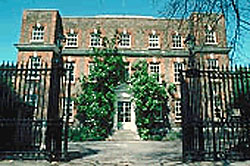
Royal Botanic Gardens, Kew

Richmond
Surrey, TW9 3AB
United Kingdom
Anna Saltmarsh
Email: a.saltmarsh@kew.org
Eimear Nic Lughadha
Email: e.lughadha@kew.org
Throughout its history, the Royal Botanic Gardens, Kew, has made important contributions to increasing knowledge and understanding of the plant kingdom with many benefits for humanity. Kew’s 19 major, world-class collections of living and preserved plants, of plant products and of botanical information, together form an encyclopedia of knowledge about the plant kingdom (http://www.kew.org/collections/index.html).
The collections form an important resource for researchers around the world and a key source for information represented in Kew’s databases and publications (http://www.kew.org/data/index.html).
At the Royal Botanic Gardens, Kew, the Herbarium plays a central role for research into plant diversity. The collections include over 7 million specimens, including approximately 350 000 type specimens. The herbarium holds over 70 000 putative type specimens from Africa and Madagascar, representing 50 percent of African plant species.
From its foundation in 1853, the herbarium collections held at Kew have grown as a result of the amalgamation of several formerly private collections. The collections include the personal herbaria of some of Britain's most celebrated scientists and explorers of the past. Sir William Hooker, George Bentham, Charles Darwin, Joseph Hooker, David Livingstone, John Hanning Speke, Richard Spruce and Ernest 'Chinese' Wilson are just a few of the famous names whose collections can be studied in the Herbarium.
The collection is still growing with a yearly addition of between 30 000 and 50 000 new specimens through a programme of joint work with overseas colleagues, expeditions, gifts and exchanges with other institutes in the UK and abroad.
The Library, Art and Archives collections includes over 150 000 books and a comparable number of pamphlets on plant taxonomy and systematics, horticulture, plant ecology and conservation and the work of botanic gardens and herbaria. There are also 4000 periodical titles, over 200 000 botanical illustrations and some 7 million sheets of archive material.
The illustrations collections range in date from the great masters of botanical illustration of the 18th Century, such as G.D. Ehret, P.J. Redouté and the Bauer brothers, through to Thomas Duncanson, George Bond and Walter Hood Fitch in the 19th Century. The holdings include a high proportion of the early originals prepared for Curtis's Botanical Magazine, together with the work of 20th and 21st Century contributors.
The Archives contain the official records of the Royal Botanic Gardens, Kew, and the papers of many botanists, gardeners and other individuals. One of the largest sections of the archives collections is the Directors' Correspondence. This collection comprises the scientific correspondence received by senior staff from 1841 to 1928, and Sir William Hooker's correspondence from before 1841 which he brought with him to Kew.
The Economic Botany Collection at Kew illustrates the extent of human use of plants around the world. The huge variety of objects, numbering over 82 000, ranges from artefacts made from plants, to raw plant materials, including a large collection of wood samples. Uses range from food, medicine and utensils, to wood-carvings, basketry and clothing. The raw materials themselves include seeds, resins and gums, dried leaves, timber and pickled fruit and flowers.
Materials contributed by Royal Botanic Gardens, Kew (K):
- Specimens
- Curtis's Botanical Magazine, "original illustrations and published plates"
- Economic Botany Collection, Kew
- Flora of Tropical East Africa
- Flora of West Tropical Africa, original illustrations
- Flora Zambesiaca
- Francis Masson, original illustrations
- Franz Bauer, original illustrations
- Herbarium Illustration and Slide Collections, Kew
- Library Collections: Baines, Thomas
- Olive Coates Palgrave, original illustrations from "Trees of Central Africa"
- Royal Botanic Gardens, Kew: Archives: African Expeditions
- Royal Botanic Gardens, Kew: Archives: Directors' Correspondence
- South Eastern Africa Expedition Photos, Kew
- Useful Plants of West Tropical Africa
- Flora Capensis
- Flora Somalia
- Flora of Tropical Africa
- Flora of West Tropical Africa
- Royal Botanic Gardens, Kew: Archives: Marianne North Images
- Plant Determination Lists
- Plant Author Names
- All contributions
